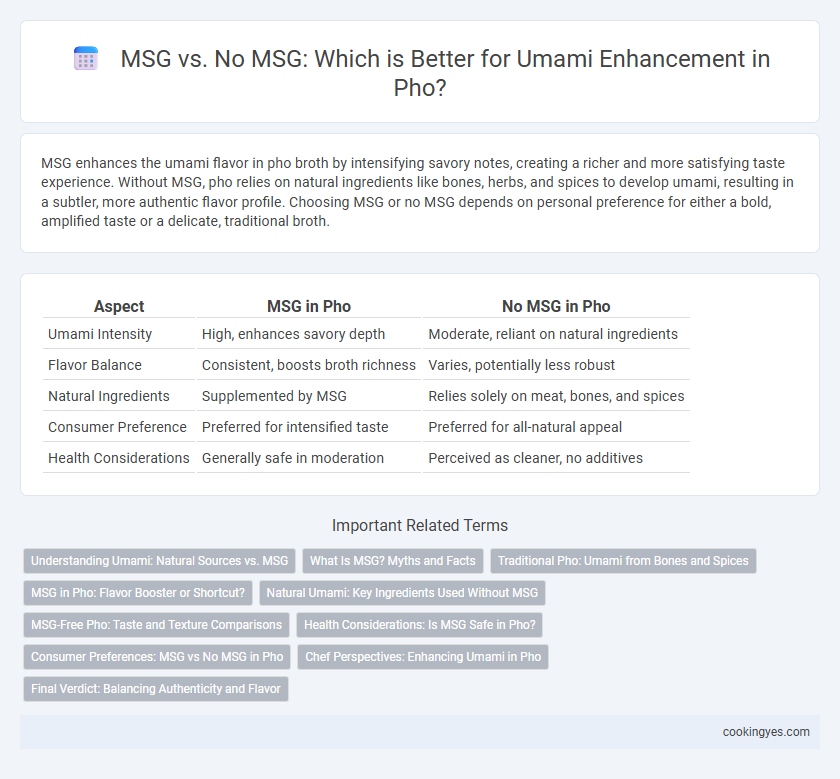MSG enhances the umami flavor in pho broth by intensifying savory notes, creating a richer and more satisfying taste experience. Without MSG, pho relies on natural ingredients like bones, herbs, and spices to develop umami, resulting in a subtler, more authentic flavor profile. Choosing MSG or no MSG depends on personal preference for either a bold, amplified taste or a delicate, traditional broth.
Table of Comparison
| Aspect | MSG in Pho | No MSG in Pho |
|---|---|---|
| Umami Intensity | High, enhances savory depth | Moderate, reliant on natural ingredients |
| Flavor Balance | Consistent, boosts broth richness | Varies, potentially less robust |
| Natural Ingredients | Supplemented by MSG | Relies solely on meat, bones, and spices |
| Consumer Preference | Preferred for intensified taste | Preferred for all-natural appeal |
| Health Considerations | Generally safe in moderation | Perceived as cleaner, no additives |
Understanding Umami: Natural Sources vs. MSG
Natural sources of umami in pho include ingredients like dried shiitake mushrooms, kombu seaweed, and concentrated beef or chicken broth, which provide a complex and layered savory flavor profile. MSG (monosodium glutamate) enhances umami by intensifying glutamate content, delivering a clean, straightforward savory taste but lacking the depth found in natural ingredients. The choice between MSG and natural umami sources affects flavor authenticity and perceived richness in pho broth, influencing consumer preferences and culinary tradition.
What Is MSG? Myths and Facts
Monosodium glutamate (MSG) is a naturally occurring amino acid salt used to enhance the umami flavor in Pho, intensifying savory taste without overpowering other ingredients. Despite myths linking MSG to health issues like headaches and allergic reactions, extensive scientific research confirms it is safe for consumption at typical culinary levels. Using MSG in Pho can create a richer, more balanced broth by amplifying glutamate compounds naturally present in ingredients such as beef bones and seaweed.
Traditional Pho: Umami from Bones and Spices
Traditional Pho achieves its rich umami flavor primarily from simmering beef or chicken bones, releasing natural glutamates and inosinate that create deep savory notes. The combination of aromatic spices such as star anise, cinnamon, and cloves further enhances the broth's complexity without added MSG. This authentic method emphasizes natural umami sources, resulting in a balanced and fragrant Pho experience.
MSG in Pho: Flavor Booster or Shortcut?
MSG in pho acts as a powerful umami enhancer that elevates the broth's depth and richness by amplifying natural savory compounds like glutamates found in beef bones and herbs. While traditional pho relies on slow-simmered bones, spices, and herbs for complex flavors, MSG offers a quicker, consistent boost to achieve that signature savory taste. The debate centers on whether MSG is a genuine flavor booster that complements pho's authentic profile or an artificial shortcut that bypasses the slow, nuanced development of natural umami.
Natural Umami: Key Ingredients Used Without MSG
Natural umami in pho is primarily enhanced by ingredients like dried shiitake mushrooms, kombu seaweed, and beef bones, which release glutamates naturally during slow simmering. Fish sauce and caramelized onions further boost the broth's savory depth without the need for added MSG. These traditional components create rich, complex flavors that deliver umami naturally and authentically.
MSG-Free Pho: Taste and Texture Comparisons
MSG-free pho maintains a rich umami flavor through the slow simmering of beef bones, charred onions, and star anise, resulting in a complex, naturally savory broth. The absence of monosodium glutamate highlights the subtle sweetness and depth of the broth, offering a cleaner taste with a slightly lighter mouthfeel compared to MSG-enhanced versions. Texture in MSG-free pho emphasizes tender rice noodles and well-cooked, succulent meat slices, creating a balanced and authentic culinary experience.
Health Considerations: Is MSG Safe in Pho?
Monosodium glutamate (MSG) is commonly used to enhance the umami flavor in pho without significantly altering its nutritional profile. Scientific studies indicate MSG is generally recognized as safe by regulatory authorities such as the FDA and EFSA when consumed within typical dietary levels. For individuals sensitive to MSG, avoiding its use or opting for natural umami sources like shiitake mushrooms and kombu seaweed provides a health-conscious alternative in pho preparation.
Consumer Preferences: MSG vs No MSG in Pho
Consumers show divided preferences regarding MSG use in pho, with a significant segment favoring no MSG due to health concerns and natural ingredient emphasis. Studies reveal that while MSG enhances umami and flavor depth, many prefer pho made with traditional broth simmered from bones and spices that naturally impart rich taste. Market trends indicate rising demand for MSG-free pho options, reflecting a shift towards clean-label and organic food choices among health-conscious diners.
Chef Perspectives: Enhancing Umami in Pho
Chefs emphasize that MSG selectively amplifies umami in pho without overpowering the broth's natural flavors, making it a favored tool for flavor balance. Many highlight that when used sparingly, MSG enhances the savory depth derived from ingredients like beef bones, star anise, and ginger. However, some prefer relying on slow-simmered broth techniques and natural umami sources such as dried shiitake mushrooms and fish sauce to achieve authentic richness without added enhancers.
Final Verdict: Balancing Authenticity and Flavor
Using MSG in pho enhances umami depth and savory richness, providing a more robust flavor profile while maintaining a clean, savory broth. Traditional recipes without MSG rely on slow-simmered bones and fresh aromatics to develop natural umami, appealing to purists seeking authenticity. Balancing these approaches, chefs optimize pho broth by selectively incorporating MSG to elevate taste without compromising the dish's cultural integrity.
MSG vs no MSG for umami enhancement Infographic

 cookingyes.com
cookingyes.com